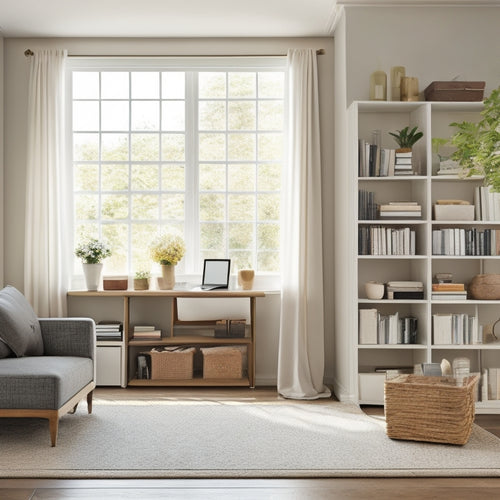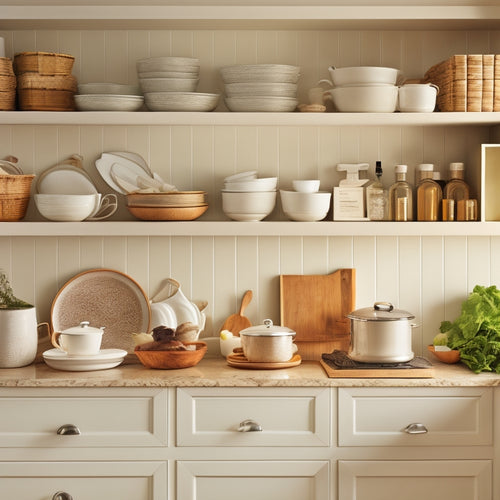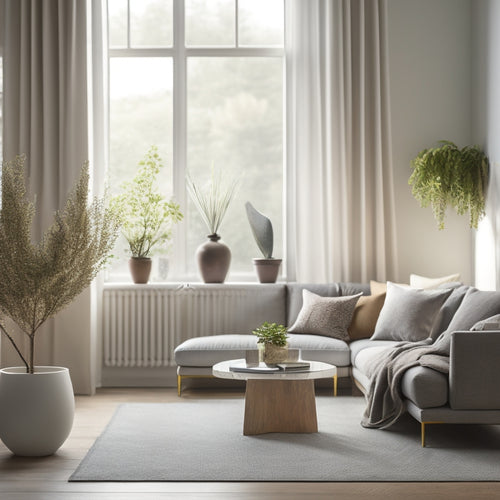
3 Best Ways to Boost Closet Storage With Bins
Share
You can create more closet storage space by using bins strategically. First, utilize stackable bins to categorize similar items, labeling and color-coding them for easy identification. Next, maximize shelf space by reserving it for bins that fit snugly, labeling them to quickly identify contents. Finally, hide clutter with decorative bins that blend into your closet's aesthetic. By implementing these strategies, you'll be able to conceal clutter, free up space, and maintain style. To discover more clever ways to optimize your closet's storage potential, keep exploring these techniques and ideas.
Key Takeaways
• Select compatible bins that are robust, durable, and visually appealing to maximize closet storage and maintain organization.
• Choose bins that fit snugly on shelves and consider item size and shape for efficient storage and easy access.
• Utilize decorative bins that match the closet aesthetic to store items like socks and hats, keeping the closet organized and clutter-free.
• Store out-of-season or less frequently worn shoes in labeled bins to free up floor space and keep them dust-free.
• Use stackable bins to store seasonal accessories and decorations, keeping them organized and easily accessible.
Utilizing Stackable Bins Effectively
How can you maximize the storage capacity of your closet by strategically stacking bins, considering factors such as bin size, shape, and material to secure a sturdy and accessible storage system?
To get the most out of your bins, start by selecting bins that are compatible in size and shape, allowing you to stack them efficiently. Consider the material of the bins as well, opting for robust and durable options that can support the weight of the items you plan to store.
Once you've chosen your bins, think about labeling options to make sure you can easily identify what's inside each one. You can use labels or stickers to mark the contents, or even color-code your bins to create a visually appealing and organized system.
Color coordination can also help you categorize similar items, such as storing all winter clothing in blue bins and summer clothing in yellow bins. By strategically stacking and labeling your bins, you'll be able to find what you need quickly and easily, and make the most of your closet's storage capacity.
Maximizing Shelf Space With Bins
You can further optimize your closet's storage capacity by reserving shelf space for bins that are specifically designed to fit snugly on shelves, allowing you to store items like folded clothes, accessories, or linens in an organized and easily accessible manner.
When selecting bins for your shelves, consider the size and shape of the items you want to store. This will guarantee you're making the most of the available space. Labeling bins is also essential in maximizing shelf space, as it helps you quickly identify what's inside, making it easier to find what you need.
Additionally, consider utilizing underbed storage bins for items that you don't need frequent access to, such as out-of-season clothing or bedding. By doing so, you'll free up valuable shelf space for more frequently used items.
Hiding Clutter With Decorative Bins
Decorative bins can seamlessly blend into your closet's aesthetic while concealing clutter, providing an attractive solution for storing items like socks, hats, or belts. These bins come in various styles, shapes, and materials, allowing you to choose the ones that fit your closet's design.
By using decorative bins, you can keep your closet organized and clutter-free without sacrificing style.
Here are three ways you can use decorative bins to hide clutter:
-
Organizing shoes: Store your out-of-season shoes or less frequently worn shoes in decorative bins to keep them dust-free and out of the way.
-
Storing seasonal items: Use decorative bins to store seasonal items like winter accessories, summer hats, or holiday decorations, keeping them organized and easily accessible.
-
Concealing cluttered areas: Place decorative bins in areas where clutter tends to accumulate, such as near a closet entrance or under a shelf, to keep items like bags, scarves, or belts organized and hidden from view.
Frequently Asked Questions
Can Bins Be Used for Storing Items Other Than Clothing?
You can use bins to store items beyond clothing, like kitchen utensils for better organization or garage tools for efficient storage, making them a versatile solution for decluttering and streamlining various spaces.
Are Clear Bins Better Than Opaque Bins for Closet Storage?
When choosing between clear and opaque bins, you'll want to weigh organizing efficiency and aesthetic appeal. Clear bins let you see contents, making it easier to spot items, while opaque bins hide clutter, creating a neater look.
How Often Should I Clean and Maintain My Storage Bins?
Imagine Sarah, who tidies her closet bins every month, discovering hidden clutter and dust bunnies. You should follow her lead, setting aside time for monthly cleaning and organizing tips, like wiping down bins and rearranging contents to maintain a clutter-free space.
Can Bins Be Used in Closets With Slanted or Angled Ceilings?
When dealing with slanted or angled ceilings in your closet, you can adapt by utilizing hooks to hang bins or baskets, and utilizing shelves specifically designed for angled spaces to maximize storage capacity.
Are Fabric Bins a Good Option for Storing Delicate Items?
When storing fragile items, you'll find fabric bins are a great option, offering gentle protection and versatility in your storage options; they're an excellent organizing solution for delicate items that require extra care.
Related Posts
-

10 Essential Skills for Mastering Home Organization
You're ready to take control of your space and transform it into a haven of calm and productivity. Mastering home org...
-

Why Kitchen Cabinet Organization Matters Most
You're likely losing more than just time and ingredients when you can't find what you need in your kitchen cabinets -...
-

Streamline Your Space: Decluttering Strategies for Minimalists
You're wasting time and energy maneuvering through cluttered spaces, which is why streamlining your space is essentia...


